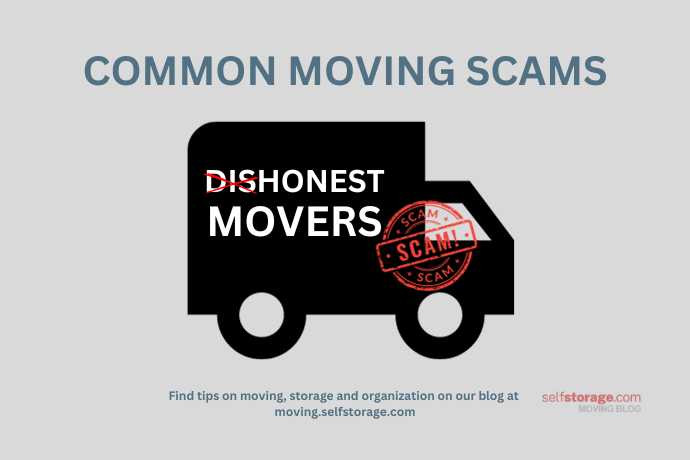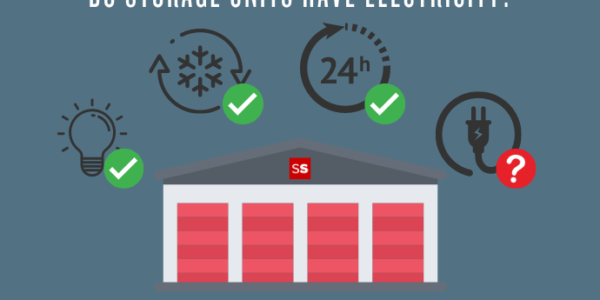What’s covered in this article – click on a link to learn more:
- What is a moving scam
- How to recognize the red flags
- The most popular moving scams right now
- The aftermath of a moving scam
- Additional tips for a safe and secure move
Moving is an exciting but often stressful experience, and the last thing you need during this time is to fall victim to a moving scam. Believe it or not, there are many common moving scams that still exist today, and our goal is to provide you with valuable insights into recognizing, avoiding, and protecting yourself against these fraudulent schemes. We’ll cover a range of topics, including the warning signs, specific scams, and the essential steps to safeguard your move to hopefully ensure a smooth and secure relocation.
What is a moving scam, anyway?
Moving scams refer to fraudulent practices carried out by dishonest moving companies to exploit unsuspecting customers during their relocation. These scams can take various forms, including utilizing fake credentials, overcharging, taking your belongings hostage, and bait-and-switch tactics. Understanding these scams is crucial for ensuring a safe and hassle-free moving experience.
When you move, you entrust your belongings, time, and money to a moving company. Making an informed decision is the first best start. But know that you can even do all the due diligence in the world to ensure a stress-free move and still get taken advantage of. Which is what happened to Lisa Schockemoehl, a property manager in Bradenton, FL.
“I was going from Greenville, South Carolina to Rochester, Minnesota,” she said. “When you’re moving states, you hire a moving company, right? They come pick up your stuff, move it and the company pays for it. The people I dealt with lining it all up were so amazing. They were the sweetest people to talk to and so easy to work with. I learned later on that it was all a lie. This was the most horrific experience to date for sure.”
While an unfortunate experience can happen, being able to spot the most common moving scams is essential because it helps you protect yourself from unscrupulous operators who could potentially damage your property or take your money.
How to recognize the moving scam red flags
Before we dive into specific moving scams, it’s essential to understand the common warning signs that can help you recognize potentially fraudulent moving companies. Here are some key red flags to be aware of and what you can do to protect yourself:
Fake credentials
Legitimate moving companies are required to have proper licenses issued by the appropriate authorities. Ones suspected of scamming people have a habit of doing business under new names.
One of the first steps in avoiding moving scams is to verify the company’s credentials. Make sure they are registered and have the necessary permits to operate legally. You can typically check a company’s license through the Federal Motor Carrier Safety Administration (FMCSA) website. By federal law, movers are also supposed to provide customers with a booklet called “Your Rights and Responsibilities When You Move.”
Online reviews can be a valuable source of information when choosing a moving company. However, some scammers post fake reviews to create a positive image of their services. Look for patterns in reviews, such as overly positive feedback, generic language, or a lack of details. Genuine reviews often include specific information about the move and the company’s performance.
Overcharging and hidden fees
Moving companies typically provide customers with estimates based on the weight of their belongings and the distance they need to be transported. Be sure you know what factors can influence the final cost of your move.
Did you notice any suspicious fees or scam quotes? Moving scams often involve overcharging and adding hidden fees to the final bill for things like living in a multi-story home or apartment or inflated prices for packing materials. Watch out for vague or ambiguous language in your contract, which could be a sign of potential hidden charges. And never sign a blank contract, a reputable moving company will provide a clear and itemized breakdown of all costs.
Bait-and-switch tactics
Bait-and-switch tactics involve promising one set of services and prices but delivering something entirely different. In this scam, dishonest moving companies entice customers with low quotes and attractive offers, only to change the terms once the move is underway.
Which is what happened with Schockemoehl. The people she initially conversed with were selling their services making her believe they were the ones she would work with. But, in reality, they outsourced the actual moving labor to a third-party site where anyone (licensed or not) could pick up the job. “I was thinking the people I spoke with originally were the ones taking care of my stuff,” she said. “But then it was up for grabs, they let any company decide to take the job over. And they never disclosed that they’re going to hire a random person or company to do the actual labor.”
If a moving company gives you an estimate without doing an on-site inspection or does a hurried walk-through of your home, they may be planning a scam. Do you pay movers upfront? Reputable movers will not demand cash or a large deposit up front.
To protect yourself from bait-and-switch tactics, always get a written agreement that clearly outlines the services and costs and do not pay anything before the move. If a deal seems too good to be true, it probably is.
The most popular moving scams deceiving people right now
Now that you know how to recognize red flags, let’s explore some of the most common moving scams in detail:
The non-binding estimate scheme
Non-binding estimates are often used by scammers to lure in customers with low initial quotes. Once the move is in progress, they increase the prices substantially, leaving you with little choice but to pay the inflated amount.
Federal law requires either a non-binding estimate (initial payment cannot exceed more than 10 percent above the original estimate) or a binding estimate which guarantees one price for the move and all extra services.
The disappearing movers scam
In this scam, rogue movers arrive at your doorstep and load your belongings onto their truck. However, when you reach your destination, they are nowhere to be found. To protect yourself from the disappearing movers scam, only hire moving companies with a physical address and a reputable online presence. Check for online reviews and ask for references.
Holding possessions hostage
What is a hostage load? The term “hostage load” refers to a situation where a moving company refuses to deliver your belongings until you pay an inflated fee. Scammers may hold your possessions hostage, leaving you with little choice but to comply with their demands.
Unfortunately, Schockemoehl’s story continued with this movers scam. After she called to confirm the date she could expect her belongings to arrive, she was told she needed to pay the rest of the amount owed first. “They told me that my stuff would sit in an Atlanta storage facility unless I paid the rest,” she said. “When I said, ‘so you’re basically holding my stuff hostage,’ they reiterated that it would not be released until they were paid. I had to involve my company’s lawyers because, for one, they were paying the expense of my things being moved since it was for work, and two, because I didn’t know what else to do.”
Obviously one way to avoid falling victim is to work with a reputable moving company. You can also take steps to protect yourself, such as documenting the condition of your belongings before the move to have evidence in case disputes arise. And then insist on a written contract that outlines all terms and fees before the move begins.
The phantom movers trick
This scam involves companies that claim to be affiliated with well-known moving brands but are not. They use similar logos, names, or websites to deceive customers. To protect yourself from the phantom movers trick, verify the company’s credentials, and check for inconsistencies in their branding and online presence.
The aftermath of a moving scam
While Schockemoehl’s story is an extreme case of what can go wrong, there are some things you can do to avoid a moving scam. When she did end up getting her things, most of her stuff had either been stolen, damaged, or was in such poor condition that it was unusable. “When I saw the truck pull up with my things, my brand new mattress was tied to the back of the truck and had come all the way to Minnesota from Atlanta in the pouring rain,” she said. It gets worse (if you can believe that). “I started crying. My TV stand came out in six pieces and it’s not even meant to come apart. They tried giving me someone else’s 60-inch TV. My dining table had a crack along the side where they had attempted to super glue it together. My sofa was missing the back cushions. I had picture frames from my grandmother that were all demolished. It was absolutely terrible.”
Schockemoehl’s company ended up trying to fight the moving scam and ended up cutting their losses, which is what the fraudulent companies hope you’ll do. “I know the risk management folks were trying to reach out to the company,” she said. “They were going to sue them and never got anywhere with it. They ended up giving me a check for $5,000 to buy new stuff and my company lost money on the deal.”
Additional tips for a safe and secure move
In addition to understanding common moving scams and your legal rights, here are some practical tips to ensure a safe and secure move:
- Seek recommendations: Ask friends, family, or colleagues for recommendations when choosing a moving company. Personal referrals can be a valuable source of trustworthy information.
- Get multiple estimates: Obtain estimates from at least three different moving companies. This allows you to compare prices and services to make an informed decision.
- Insist on a written contract: Never rely on verbal agreements. Ensure that all terms, fees, and services are detailed in a written contract before the move begins. Read the contract thoroughly and ask questions if anything is unclear.
- Keep an inventory list: Create a detailed inventory list of your belongings. This list can help track your items and identify any missing or damaged items during the move.
- Be present on moving day: If possible, be present on moving day to supervise the process and ensure everything is loaded correctly. This can help prevent potential issues.
- Document everything: Take photos or videos of your belongings before the move to document their condition. This will serve as evidence in case of damage or disputes.
Understanding common moving scams and taking steps to protect yourself is crucial for a successful and stress-free relocation. By recognizing the red flags, learning about specific scams, and following these tips, you can ensure that your move goes smoothly and your belongings remain safe. Remember that knowledge is your best defense against moving scams, so stay involved, ask the right questions, and make informed choices when selecting a moving company. Don’t let fraudulent operators spoil the excitement of your new adventure – empower yourself with the information and tools to ensure a smooth and secure move.





